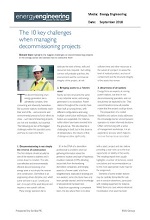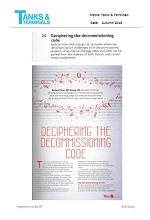With decommissioning now a seemingly common practice in the oil and gas sector, it is imperative that site owners and operators acknowledge the complexities involved with projects of this nature. Where do the key decontamination challenges lie, what role does technology play and what insight can be gleaned from the analysis of both historic and current sector assignments? RVA Group’s managing director Richard Vann recently shared his thoughts on the topic with industry journal Tanks & Terminals – if you missed the issue, you can read the article in full below…
There can be no denying the hiatus in oil production that swept across many parts of the globe with force, around three years ago. Multiple refineries and storage facilities closed or downsized – either as part of planned strategic decisions or because there was no other commercially viable solution to maintain operations.
The shutdowns, whilst numerous, were managed differently, on a case by case basis. Some assets were mothballed in order to safely postpone any further decision making, at least for the short term. For other terminal owners, the priority was to move towards a safe but swift decommissioning project at the earliest possible opportunity.
Of the dismantling and demolition works that commenced, some schemes of course reached completion. Others however were limited in extent due to mounting commercial pressures, with tanks and terminals having now deteriorated to varying degrees as a result.
In the past 6-12 months, decommissioning specialists have been engaged to re-start a number of these paused projects, particularly in central Europe. So, the peak level of site closures may have long passed, but the volume of decommissioning work either recently or currently underway, is now significant.
The decommissioning drivers
The aforementioned hiatus arose, of course, because of basic economics. Oil prices fell – due to both political, as well as supply and demand influences. The uncertainty of what the future would bring consequently made it difficult for many oil, gas and petrochemical facilities – already working on tight margins – to sustain production.
Plant inefficiency is, of course, another catalyst for decommissioning activity. Terminals naturally start to reach the end of their design life and, as regulatory frameworks begin to dictate more frequent inspections and maintenance regimes at this point in their chronology, the scenario can soon become financially unmanageable. EHS (environment, health and safety) considerations also rise as plant conditions worsen, which represents a corporate and social responsibility burden that many operators are – understandably – unwilling to bear.
Deciding on a decommissioning plan
A feature for Tanks in Terminals in 2017 importantly drew attention to the fact that decommissioning should not be viewed merely as an extension of normal operations, or the reverse of construction and commissioning. It is an entirely different exercise that requires a comprehensive skill-set in order to undertake these inherently hazardous exercises safely, with minimal environmental impact, and to ensure the most commercially robust solution for the business during this potentially difficult period.
External specialists who take on such projects on a daily basis, can therefore provide a value-adding resource to help support operators with the industry’s decommissioning assignments. This involvement should be sought as early as possible, as sector- and discipline-specific knowledge could shape the entire direction of ‘what next’.
A feasibility and options study is a logical starting point for all involved. Often commencing with a series of management workshops, this exploratory process helps to uncover the key issues associated with a plant, project and site, before providing a clear view as to the true opportunity or liability of the works. The findings documented in the resulting report will then usually highlight a number of technical, costed conclusions and recommendations as to the most appropriate route map for the decommissioning assignment.
Whilst in many cases opportunities are limited, it may be possible to dismantle some assets for resale, for example. This is far from a straightforward exercise, as the decontamination, laser scanning, match-marking, physical separation, preservation, precise cataloguing and packing of the plant is often required, so that it can be meticulously reassembled.
The need for decontamination
Technical decommissioning articles commonly home in on the demolition phase of a project, with a great degree of attention quite rightly focusing on the complex methodologies involved with safely bringing a refinery’s varied structures to the ground. But it is crucial to pay equal thought to a more imminent phase of works – decontamination.
Given the time that may have lapsed since a tank, for example, was first mothballed, decommissioning teams face a significant hurdle when it comes to completing the decontamination of such a partially-cleaned structure. It is almost inevitable that the knowledge of the site’s own personnel will have long been lost, which means it is difficult to establish the known state of all assets. This is often the initial priority. It is highly likely that residual product may still be present and the longer a plant has been left, the greater the risk of hazardous atmospheres or a loss of containment. The potential for both safety and environmental issues to manifest is therefore very real.
As is the case with many strands of business activity, technological advancements are fuelling innovation in this respect. Drone technology, for instance, is aiding the safe inspections of tanks and terminals, during these initial planning and surveying stages.
As a general rule, the greater the degree of structural dilapidation, the higher the level of risk associated with vessel entry. So, it is far safer to remotely assess the integrity of a terminal that has not been sufficiently maintained for years, via a piloted drone, than it is for personnel to manually inspect the asset.
Structures can quickly become overgrown with moss and other foliage, for example, and the consequences associated with concealed holes in walkways or detached staircases, could be catastrophic if these hazards remained unidentified. Drones help to circumnavigate this problem, by determining safe access points and work areas for next-step on-site operatives.
This methodology is also relatively inexpensive; quick, as there is no need to erect any scaffolding or other fixed access equipment; and convenient, as it provides a ‘birds-eye’ picture of structures, however complex, without the need for excessive manpower on the ground. Any ethical decommissioning specialist would agree that it is far better to lose a dozen drones than it is for a single person to cut their finger.
If drones are flown over and/or within an even partially operational site, added precautions should of course be taken. Potentially explosive atmospheres must be clearly zoned, as it is likely that flights will only be permitted within predefined distances. Limitations may also be placed on whether the drone can fly inside a structure, if it could represent a possible source of ignition. To the extent of RVA’s knowledge there are not currently any ATEX-rated drones in the market, but manufacturers will surely move quickly to address this gap.
This is not to say that this technique will completely negate safety challenges, of course – drone inspections represent just one aspect, of a single phase, in a potentially lengthy project. But the anticipation of these and other such challenges, is key to being able to comprehensively manage them.
Decommissioning in practice
RVA has encountered a number of very different decommissioning projects in this sector, each with their own feasibility study outcomes and therefore each with their own defined course of action thereafter.
Fifteen years ago, for example, Total engaged RVA to specify the decommissioning works for three road and rail terminal distribution depots – Leeds, Langley and Sunderland (UK). Health and safety plans were carefully drafted for all, with the latter site subsequently sold to another operator. At Leeds and Langley, the sites were shut down and dealt with promptly, with the work carried out soon after and RVA adopting visiting roles thereafter to oversee the project.
When Murco’s refinery in Milford Haven (UK) closed in 2014, RVA was brought in to specify all work ahead of the site’s demolition. The day before the demolition was due to begin, the plant was sold to a company in Pakistan, with RVA later re-engaged to write the alternative dismantling specification. With this project, it was agreed that RVA’s involvement would cease when the contractor was engaged, but the piecemeal decommissioning, disassembly and export of the entire refinery is currently underway, with a reported completion date of Autumn 2018.
In the case of Petroplus, RVA produced a feasibility and options study for an 8.5-acre site in Teesside (UK) – the output of which was then used to formulate a detailed specification for the refinery decommissioning and dismantling works. Petroplus was placed into administration before the project could be executed, but the groundwork has been done for future use.
Fast forward to the present day and two costing studies are currently being undertaken by RVA on terminals in Europe. These will act as strategic management tools that will enable the site owners to make informed decisions about the best course of action for their redundant sites.
Reactive support
There are some instances where decommissioning activities are not pre-planned of course. In the case of Buncefield (UK) – when a catastrophic escape of petroleum caused a mass explosion which overwhelmed 20 storage tanks in 2005 – RVA was appointed by Amec post-trauma, to develop the required specification of work.
The Government authorised the use of Aqueous Film Forming Foam (AFFF) to extinguish the fire on the long-burning assets, but the foam itself added to the environmental impact of the disaster.
With buildings bent double, RVA therefore wrote the specification to deal with the safe dismantling of the unstable structures, as well as the cleaning regime required to sanitise the site of the foam, without disturbing the forensic evidence required to piece together the cause of the explosion. A reactive role was maintained over the 12 months that followed, as the distressed tanks and structures were carefully brought to the ground.
A competent supply chain
It is important to note that other heavy industries – beyond the realms of oil, gas and petrochemical refining – are currently experiencing operational challenges too. So, as further site closures are announced globally – necessitating even more decommissioning projects – finding a competent supply chain will become increasingly difficult.
However, there are a refined number of highly-equipped decommissioning consultants, project managers, decontamination specialists, demolition contractors and explosives experts, willing to travel throughout the world, to ensure these works are completed to the highest possible standard. All the site owner needs to prioritise, is their involvement.
If you would like to speak to RVA Group about the contents of this article, or you’re interested in decommissioning advice for your own project, please contact us via our website or call 020 8387 1323.









 In the latest issue of Energy Engineering, RVA Group’s managing director Richard Vann gave his views on the 10 main challenges involved in the management of a decommissioning project…
In the latest issue of Energy Engineering, RVA Group’s managing director Richard Vann gave his views on the 10 main challenges involved in the management of a decommissioning project… RVA Group’s managing director Richard Vann recently shared his thoughts on decontamination and decommissioning challenges with industry journal Tanks & Terminals…
RVA Group’s managing director Richard Vann recently shared his thoughts on decontamination and decommissioning challenges with industry journal Tanks & Terminals…